Air pressure regulators limit the maximum pressure that can reach your tools. You should use one to protect your air tool’s lifespan. Now, for my contractor friends who are running around rooftops with pancake compressors, you don’t need to buy an external regulator.
But for my friends working in large-scale industrial shops, you need a regulator. A regulator is a critical device that lowers the source pressure to match the maximum operating pressure of the tool that you are using. This prevents tools from overheating or becoming damaged by excessive pressure. It also helps to save energy and money in larger operations.
A regulator does this with an internal rubber diaphragm and a tension spring. As you adjust the regulator knob tighter, the rubber seal is closed more tightly, reducing airflow.
Less airflow means less pressure.
Air regulators decrease high air pressure into low air pressure. They cannot increase pressure output higher than pressure input.
The input to the regulator will be the air compressor. The output will connect to your end device using an air hose.
When Does An Air Compressor Need A Regulator?
f you were to remove the regulator from your air compressor, you would be supplying raw compressor pressure to your pneumatic tool. In a lot of cases, this pressure supply is 150 PSI or higher, which will damage most pneumatic tools.
If you are only using compressed air for filling tires, a regulator is not as important. However, most readers will also use their tank for air tools, and thus, they need the regulator.
See Related: Pressure Switch Adjustments
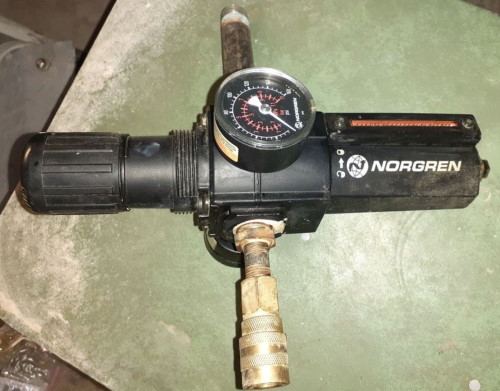
In a hurry? Quick Links:
Disclaimer: This article is for information purposes. Compressors can be deadly to work with and this article does not provide enough training to qualify someone to work on a compressor safely.
Air (Pressure) Regulation For Industrial Use
Industrial compressors will often be used to power a single device and will have the regulator built into the compressor itself. There are two main controls for these devices
Continuous Flow
These units rely on amplification and regulating speed to maintain a steady flow of air supply to the system
Load/Unload
These units operate more like the consumer pressure switch, and respond to pressure changes in the line. These allow for greater pressure variations.
Why Regulate Your Air Compressor?
Each tool requires an exact pressure. For the small shop, the regulator controls the airflow to the downstream pressure of the air system (even if that is a solo nail gun).
In larger factories, a high-pressure line runs through the entire shop, and air pressure regulators are used at each station throughout the shop to create lower pressure that will meet the demands of each tool.
If you are working in a large factory, it is a common job responsibility to frequently check each pressure gauge to ensure the proper pressure is being used.
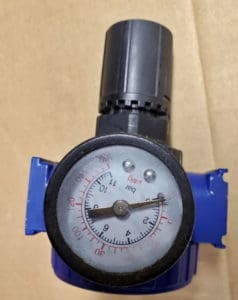
Tool Lifespan
Ultimately, most small tools use about 90 PSI. If you run 150 PSI unregulated air through them, you’ve shortened their life span to just a few uses before you blow their seals.
A compressed air regulator will help remove oil and debris from the air hose while protecting the internal seals of your pneumatic tool from too much pressure. (Compressors may have air intake filters as well).
Air Pressure Injection Injury
In shop class, we were instructed not to spray the air compressor on our hands as it could push air through the skin and cause an air embolism in our veins.
I thought that was a little odd since I had been playing with Grandpa’s air compressor since I was 6 and had sprayed my hand (and my sibling’s faces) countless times.
Maybe I just got lucky.
As the National Institute Of Health (NIH) points out in this report, the risks of a high-pressure injection injury can be wide-reaching and difficult to repair.
Air pressure over 100 PSI can easily peel the skin off your hand and damage the underlying tissues.
Air Compressor Pressure Regulators Are Pulse Dampening
Air systems are fluid. Just as with hydraulic systems, every pulse is translated throughout the systems.
This means each stroke of the compressor piston is be translated throughout the system with tiny pressure variations. This pulsation can affect your air tools’ function.
Additionally, most compressors run only in a low-pressure situation. An air tank will store the compressed air for use. When the tank’s pressure switch detects a pressure drop, it will signal the air compressor to start. This startup surge can create uneven performance in the pneumatic tools connected to that compressed air system.
Regulators – especially electronic regulators – create constant pressure.
For example, if you have the pressure switch adjusted so that the compressor tank maintains between 100 and 120 psi, but the regulator is set at 90 psi, you should never notice a pulse.
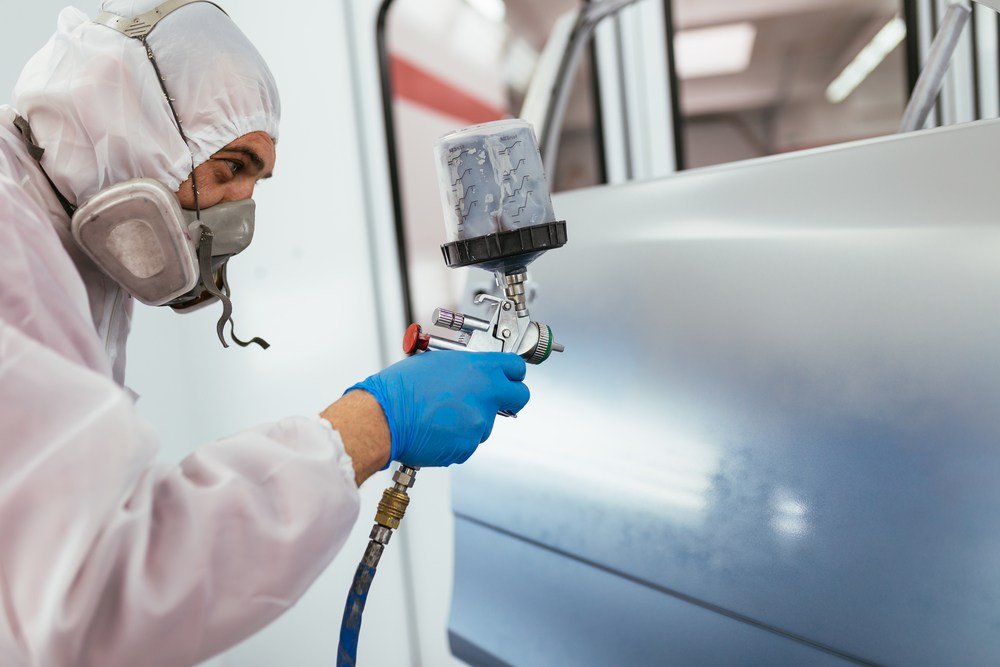
So long as the available pressure is higher than the set pressure of the regulator, you should experience a smooth flow of air.
Now, if the demand for compressed air exceeds the supply, then the pressure in the tank might drop to the point that you’ll see some of this pulsation.
Having a larger tank size can reduce how often this happens.
Air Compressor Regulators Reduce Costs
For large shops, pneumatic power is one of the larger costs.
Since a regulator limits the downstream air pressure, it helps to reduce wasted air.
By examining the tools in use and regulating the pressure down to the lowest acceptable setting, you can reduce the amount of air being used.
Large shops will sometimes provide regulators at each work station, so that the pressure can be adjusted to each use type.
How To Use The Regulator
The regulator should be installed close to the point of operation to prevent upstream pressure that will accidentally trip the pressure switch on the compressor and shut it down.
1. Turn on your compressor. You need to let the tank fill so you can adjust the pressure based on the gauges, and the pressure gauges need airflow to work.
2. Unlock the large control knob. Generally, this requires you to push down or pull up on the knob to engage it.
3. Observe the pressure gauge and turn the knob slowly in a clockwise direction to reduce to the desired pressure.
4. Relock the knob into the new pressure setting.
This is one of those things that newbies forget to adjust. If you are loaning your tools to a friend, make sure everything is adjusted before you send it to them.
Components of an Air Compressor Pressure Regulator
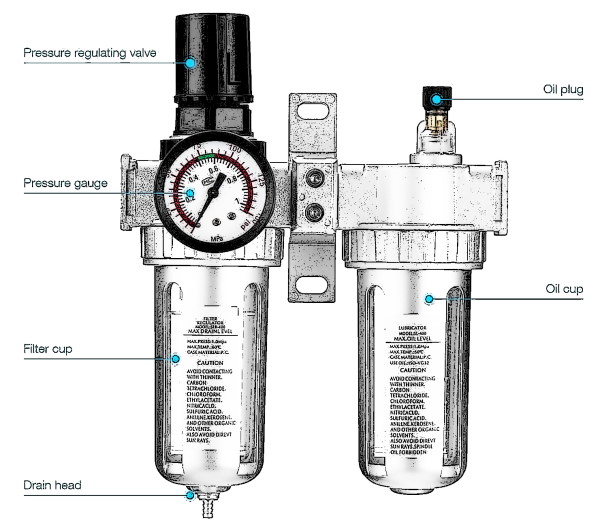
There will be a few major parts:
- Large control knob
- Possibly a gauge to see the pressure
- An inline filter
- A spring and seal
The pressure inside of the tank is controlled by the pressure switch. This switch controls the cut in and cut out pressure when the compressor should engage in. The pressure switch is a cutoff safety mechanism that controls the tank pressure and the safety of the compressor mechanisms. (Generally, you don’t need to adjust the pressure switch unless you are replacing it.)
It is a defense against tank over-pressurization.
The regulator valve controls the pressure setting for everything outside of the air tank.
Types of Air Compressor Pressure Regulators
One gauge will show the tank pressure, and then the regulator will have a separate gauge that shows the amount of pressure going to the compressed line.
When shopping for a new one, there are some added options you can get.
- Includes Air Filter
- Includes Air Filter and Desiccant (drying)
- Includes Water/Oil Separator
- Electronic
- With locks
- With or Without Gauges
- FRL (Filter-Regulator-Lubricator setups)
All of these are industrial-grade relieving regulators that are generally installed between the compressor and the air tool.
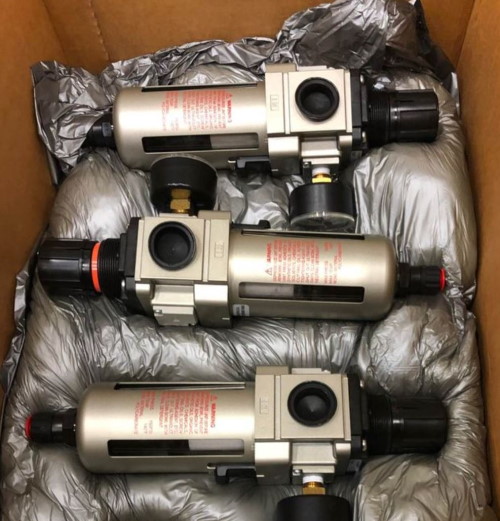
When shopping for a new regulator, it should be rated for the max PSI that your compressor can produce. If your compressor is rated for 155 PSI, you shouldn’t buy a 145 PSI regulator.
At a minimum, I like to have an air filter on mine. An air filter and desiccant are nice if you are sandblasting or running a spray gun.Having a water trap is especially handy for humid summers. Just turn the T-shaped drain valve at the bottom to release the water.
Having a water trap is especially handy for humid summers. Just turn the T-shaped drain valve at the bottom to release the water.
Precision models will hold line pressure within .5 to 1.5 PSI. You can shop based on their accuracy.
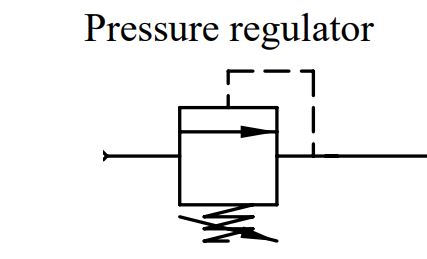
While not as common, these can be set up in a master-slave configuration. A master can be air-piloted to a slave that is installed remotely. This makes it ideal for hard-to-reach or hostile locations.
In large shops, it is common to have individual regulators installed at each station. This offers the ultimate control and allows you to get the exact pressure.
The Air filter helps to reduce the amount of oil and grime that reaches your air tools, while the drying system helps to capture water. A good regulator extends the life of your tools.
Relieving & Non-Relieving Air Regulators
Most air compressors use a relieving air regulator. If, for some reason, the downstream air pressure exceeded the amount set by the regulator, the excess would be vented back into the atmosphere.
When working with noxious gasses, a non-relieving regulator is used instead
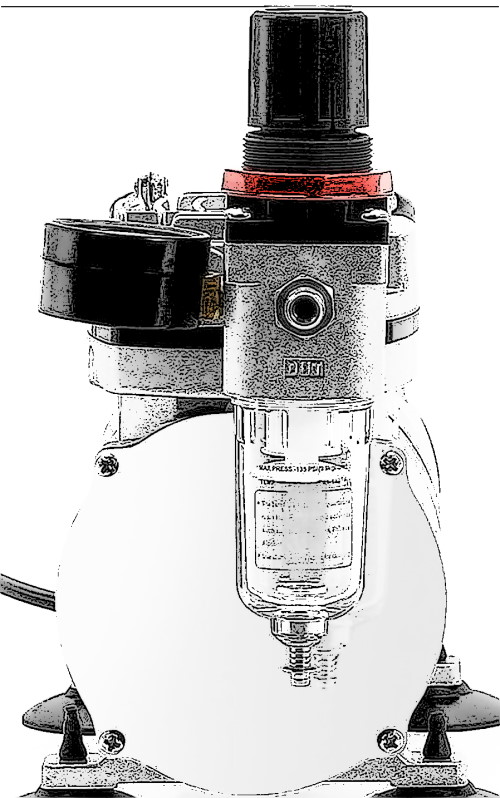
Frequently Asked Questions
My Regulator Is Restricting Too Much CFM
This is more of an advanced problem. Since these work by reducing the airflow, it is possible that a small model will also reduce the CFM too much. Also, there is sometimes a reverse correlation between CFM and pressure. You may need a special high CFM low PSI regulator. Options are easily available that allow for 5 PSI with 12 CFM for 1/4″ lines. You will also need a 60-gallon air compressor (or larger) to create a high CFM.
How To Tell If Air Compressor Regulator Is Bad
Generally, you are going to know it is bad because it has started leaking air, and you can’t tighten the loose area enough to stop the air leak. The other major fail point is the internal seal, which means that you cannot reduce the pressure, even with it fully tightened in the clockwise position. Random pressure drops are also a typical symptom of a bad regulator. Cheap Harbor Freight models may not last as long. I like to go with Ingersoll Rand models when possible. But all of these models are relatively cheap. When in doubt, replace.
What Happens if I Don’t Adjust It?
Pressure that is too high will ruin your tools. Pressure that is too low will cause the tool to underperform (such as nails that are driven part-way through the wood). Match the PSI of the air line to the PSI rating of your tool.
What Happens If I Install It Backwards?
These only work in one direction. If you look closely, there is a small directional arrow printed on the regulator that will indicate which way the airflow should go. If you mount it backwards, it won’t work. Generally, this does not harm the regulator, but it could harm your tools.
Why Is The Pressure Dropping Lower?
When using a high volume of air, such as when blowing dirt off of something, it can be very hard for the compressor to keep up unless you have a massive reserve. If you are fighting major pressure drops, it almost always because the demand is too high for your compressor.
 Skip to content
Skip to content

